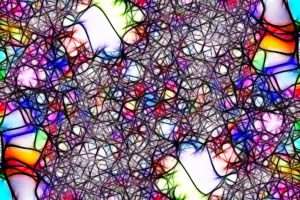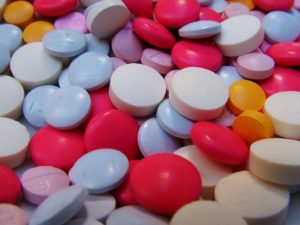Exploring the Relationship Between Histamine and Endometriosis
Histamine is a compound found in nearly all foods and is also generated through processes like ripening and fermentation. It serves as a completely natural signaling substance, produced by the body in every healthy individual. Its roles encompass contributing to inflammatory responses and the perception of pain, among other functions.
In cases of endometriosis, the consumption of foods rich in histamine can potentially escalate pain, aggravate inflammation, and adversely impact one’s psychological state [3].
Content:
Unveiling the Role of Histamine: A Comprehensive Overview

Histamine, a natural messenger substance, is produced within the body and also in food.
The natural messenger substance histamine is inherently benign, given that the human body synthesizes it. It constitutes a component of the immune system and, particularly in instances of inflammation, is accountable for triggering tissue swelling and enhanced blood circulation. Subsequently, histamine is discharged from the body’s cells in response to specific requirements.
Certain individuals experience histamine intolerance, wherein its breakdown within the body is impaired. Consequently, they are advised to limit their intake of additional histamine through their diet, if not avoid it entirely. However, for individuals in good health, histamine poses no issues. Nonetheless, achieving a completely “histamine-free” diet remains unattainable. As always, the effect hinges on the dosage.
Impact of Histamine on Endometriosis
Histamine is pivotal in instigating inflammation by stimulating and expediting various inflammatory mechanisms, including tissue swelling and heightened blood circulation [2]. Moreover, histamine exerts its influence on nerve pathways, exacerbating pain perception and intensifying its sensation.
Histamine is also involved in the production of the hormone estrogen [1]. Estrogen’s influence includes inducing painful contractions in the uterus, a phenomenon encountered during menstruation. Consequently, histamine’s participation further exacerbates menstrual pain.
Research has unveiled a notable correlation between heightened histamine consumption and an elevated likelihood of experiencing depression or anxiety disorders among women [3].
In summary, histamine should be avoided in endometriosis because the neurotransmitter:
Accelerates the inflammatory process.
Amplifies blood circulation.
Heightens the perception of pain.
Augments the uterus’ painful contractions during menstruation.
Escalates the risk of depression and anxiety disorders.
Hence, in the context of endometriosis, it becomes imperative to consciously avoid promoting histamine production and release within the body through appropriate dietary choices [4].
Intracellular Storage of Histamine: Unveiling Its Cellular Presence
To maintain a preparedness for swift responses, the body accumulates a specific quantity of histamine within certain cellular enclaves known as mast cells. Upon demand, this messenger substance is promptly dispatched from these cells. However, this mechanism is also set in motion by consuming “histamine liberators”—foods that stimulate histamine release. Some examples of such foods and their derivative products are:

Strawberries and chocolate, when consumed together, can trigger histamine release.
Strawberries
Tomatoes (including ketchup and tomato paste)
Seafood
Alcohol
Cocoa (found in chocolate)
Nuts
Exploring Histamine-Rich Foods
Histamine is not only produced within the body itself, but it is also generated during processes like ripening and fermentation in food. Consequently, the longer food is allowed to ripen or ferment, the higher its histamine content becomes. For instance, fresh cheese typically holds lower histamine levels, whereas aged hard cheeses or potent Camembert tend to contain elevated amounts. Similarly, foods that undergo prolonged fermentation or aging – such as sauerkraut, smoked ham, and wine – also accumulate significant histamine levels. When considering the adverse implications of histamine in endometriosis, certain foods should be avoided:

Here, an example of a histamine-rich combination is sauerkraut paired with salted meat, which is not recommended for endometriosis.
Sausage products (especially cured sausages)
Smoked and dried meats (like smoked ham, Bündnerfleisch, beef jerky, bacon, etc.)
Aged cheeses and other “mature” cheese varieties (Camembert, cave cheese, Parmesan, blue cheese, etc.)
Smoked fish (fresh or canned, such as mackerel, sardines, etc.)
Alcoholic beverages (wine, champagne/sparkling wine, top/bottom-fermented beer, etc.)
Soy sauce, fish sauce, wine vinegar
Yeast extracts and flavor enhancers (like food seasoning, Fondor, etc.)
Fermented foods (sauerkraut, kimchi, etc.)
Navigating Histamine Intolerance: Medication Considerations

Certain medications trigger the release of histamine.
Histamine is naturally released in the body during instances like inflammatory reactions when needed. However, certain medications can also trigger the release of this messenger substance from the body’s cells. These medications encompass commonly used active ingredients found in painkillers (such as acetylsalicylic acid, diclofenac, metamizole, and morphine), antihypertensives, and antiarrhythmics (including dihydralazine, alprenolol, verapamil…), along with specific antibiotics, drugs designed for alleviating nausea or digestive issues (like heartburn), and various other medications.
For individuals with histamine intolerance, these drugs can temporarily increase histamine release and thus should be avoided. However, if histamine intolerance is not a concern, taking these medications is typically unproblematic and does not imply they should be refrained from in the context of endometriosis.
It is important to note that not every medication induces the same level of histamine release, and patient responses can vary. Discontinuing medications without professional guidance is not advisable. Instead, alternative solutions should be explored in consultation with a healthcare provider, considering the pros and cons. For instance, instead of aspirin (acetylsalicylic acid) or Voltaren (diclofenac), Neuralgin / Nurofen (ibuprofen) can be considered as an alternative analgesic option.
How Does This Impact My Diet?

Choosing alternatives like fruit jelly instead of chocolate and fruit cake instead of nuts offers histamine-friendly options.
Achieving a diet devoid of additional histamine intake is not feasible, and it is not necessarily required to completely eliminate histamine-rich foods either. Often, spreading the consumption of certain foods across multiple meals can suffice. For example, rather than pairing salted meat with sauerkraut, one could opt for wine and then enjoy strawberries for dessert.
Practical alternatives abound: consider fresh fish as a substitute for smoked fish, cooked ham in lieu of smoked ham, fresh cheese instead of hard cheese, fruit cake over nuts, or gummy bears replacing chocolate. Industrially manufactured foods, like convenience items, often contain flavor enhancers (sometimes labelled as “yeast extract”), and it is advisable to avoid these during shopping.

Ein Ernährungstagebuch ist ein wirksamer Begleiter.
Determining the personal tolerance for histamine in the context of endometriosis is a unique process. Does consuming a specific food lead to increased pain? Is this pain attributed to histamine, or could other factors be at play? A food diary significantly aids in discerning which foods are beneficial or should be approached with caution in relation to endometriosis [5].
Summary
Histamine has the potential to exacerbate the symptoms of endometriosis. Thus, avoiding foods rich in histamine or those that trigger the body’s histamine release is prudent. Recognizing that individual bodies vary, even making minor adjustments like decreasing the consumption of certain foods or moderating their intake across the day can prove effective.
References
- Finding the Perfect Nutritionist: A Step-by-Step Guide - 5. October 2023
- Does Monk’s Pepper Help with Endometriosis? - 5. October 2023
- A Brief Overview of Dietary Fats - 29. September 2023
